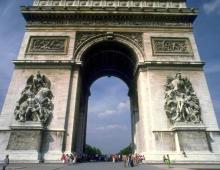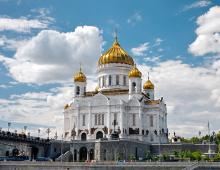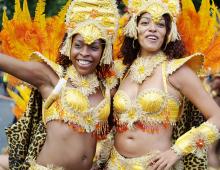Where in London: the largest street carnival. Carnival in Notting Hill - traditions of the Caribbean culture Where it takes place
Great Britain, London
Notting Hill Carnival: vivid photos and videos, detailed description and reviews of the Notting Hill Carnival 2020 event.
- Hot tours to the UK
Previous photo Next photo


Who does not know the carnival in Rio? Bright colors, dancing until you drop - it would seem that this can only happen in hot and temperamental Brazil! But no, and bright street carnivals happen in foggy Albion, no worse than the Brazilian one. Carnival in Notting Hill (a district of London) enlivens this prim European city with new exciting impressions and emotions of incendiary rhythms and dances. More than a million people visit it every year, making it the second street festival of the world after the Brazilian carnival.
More than a million people visit Notting Hill Carnival each year, making it the second-largest street festival in the world after the Brazilian Carnival.
The carnival was first held by members of the West Indian community in 1964. Then the holiday was quite small and was intended to bring a part of the Caribbean culture into the English traditions. Over time, the carnival gained momentum, attracted more and more guests, especially since the London authorities actively supported its development.
Much attention is paid to the organization of the safety of the carnival. In the narrow streets of the district, holding a large procession, which has become so popular, is associated with certain difficulties, for which significant funds have been allocated in recent years. Comfortable grandstands are now being installed for spectators, and in order to prevent the city from standing in many kilometers of traffic jams during the parade, an alternative traffic pattern is being organized.
In total, more than 12 thousand police officers work to organize order during the carnival.
Notting Hill Carnival
Carnival is held on the last Sunday and Monday of August. The most exciting part of the holiday is the dance competition between the London bands.
The participants of the festival prepare costumes and performance at their own expense, while the audience does not have to pay anything for the pleasure of admiring the dancers.
In a word - in order to look at the bright, sunny carnival, you do not need to fly to the other side of the world at all. Carnival in London is not inferior to tropical holidays, and the feeling of the location of the festival in the midst of a European city full of contrasts is only getting brighter and richer.
One of the main events at the end of the summer season is the Notting Hill Carnival, which inherited the area's name. To date, the festival is considered the largest celebration in Europe, cultivating the traditions and customs of Afro-Caribbean communities. Despite its origin, the colorful and uniquely lively carnival brings together people of all nationalities who want to take part in processions, dances, and musical performances.
History of the origin of the festival
The history of the Notting Hill Carnival goes back to the post-war years, when people belonging to racial minorities lived in the narrow streets of north Kensington, in overcrowded slums, without hot water and electricity, in absolute poverty.
Labor shortages following the end of World War II led to mass immigration to the British Isles. By the late 1950s, Notting Hill and Brixton had become overpopulated areas occupied by western Indian immigrants, Jews, Irish, Spaniards and other nationalities. However, with the exception of primitive housing conditions, visitors also faced more significant troubles. Under the leadership of politician Oswald Mosley, the British Union of Fascists was founded, which included indigenous and only white members of the working class. The slogan of the union read "Let Britain be white", and its activists accused the immigrants that the unfortunate people seized jobs, began to marry local women, and loud music came from their windows until the morning, disturbing the peace of the indigenous people. Oil was added to the fire by a riot that took place in 1958, which resulted in the death of a carpenter from Antigua.
By the end of the year, some measures were taken to ease racial tensions. Members of the British Communist Party staged protests, marching through the streets with anti-racist placards. World public figures such as Norman Manley (Prime Minister of Jamaica) visited the area giving motivational speeches. Trinidadian politician and part-time creator of Britain's first black newspaper, Claudia Jones, came up with the idea of bringing people on both sides of the barricade together by introducing them to Caribbean culture and art.
It should be noted that Jones tirelessly fought for the rights of oppressed peoples around the world. Since moving to America from Trinidad, she has been arrested four times for her activism, until Jones is finally banned permanently from America, ensuring a smooth deportation to the UK. Wasting no time and energy, Claudia Jones plunged into politics, continuing to actively fight against racism.
First Caribbean Carnival in London

The holiday got the appearance of a magnificent festival thanks to the London social worker Rown Laslett. It was she who took over the organization of the carnival: she agreed with the authorities to hold the holiday on a state holiday, warned the police about the possible noise, invited musicians, borrowed colorful costumes from the administration, borrowed carts and horses from merchants and called on all ethnic minorities living in the area to take participation in street processions accompanied by music. More than a thousand people came to the festival held by Laslett.
Laslett herself claimed that the idea for the festival came to her in a vision in which she saw people of different races dancing in the streets in colorful costumes.
The festival truly brought together nationalities living side by side and not communicating with each other. The popularity of the idea has increased every year, transforming the area into the center of events on the last Sunday and Monday of summer.
Features of the carnival

Both adults and children dress up in magnificent costumes made of bones, grass, beads, fabric and feathers. The combination of these natural materials carries a certain idea and spiritual power. Feathers, for example, were formerly used by ancient African tribes to create masks and headdresses. People believed that the feather was a certain symbol that allowed them to overcome illnesses and be reborn in a new form in their next life.
Not a single festival happens without music, so walking along the streets of Notting Hill, you can hear reggae, funk and rhythm and blues. The real "anthem" of the festival of Caribbean origin is the calypso style of music. It is known that while working on sugar plantations, African slaves did not have the right to speak, so songs became a way of communication, which later laid the foundation for a whole musical movement.
The Notting Hill Carnival is an annual street festival that draws millions of spectators to the heart of London. To rhythmic melodies in the style of reggae and salsa, participants in bright costumes, forgetting about social prohibitions and conventions, glorify the multicultural heritage of Foggy Albion.
Traditionally, since 1966, the celebration of equality and freedom takes place at the end of summer. The long weekend in August - Saturday, Sunday and Monday - is filled with bright colors and incredible fun.
The first two days are perfect for family walks, eating Caribbean kebabs, contemplating a colorful riot. All that is required of the participant is to succumb to the general mood, dressed in colorful clothes and armed with a whistle.
The culmination and denouement of the Afro-Caribbean celebration falls on the final day - Monday. From 8 am the streets of West London come alive to the sound of drums and crowds of celebrating. After the parade and the official part of the carnival, those who want to walk to victory fill the local pubs and bars.
Like any mass event, Notting Hill requires increased attention from the police, aimed at preventing crime. Often during the procession, you can see the boarded-up windows of private shops and shops, as well as anti-vandal barriers. As a rule, unpleasant situations can be avoided by leaving the holiday before the general madness reaches its climax.
Story
The Notting Hill Carnival dates back to the 1960s. At that time, the issue of racial disunity and hatred was very acute. The intransigence of white Londoners and black migrants from the Caribbean region increasingly turned into armed clashes.
The turning point came in 1959, when a group of negative activists stabbed to death a native of Antigua - Kelso Cochrane. This event had a sobering effect on people and laid bare the full horror of the events taking place. Deciding that this could not continue, communist Claudia Jones, in protest against violence and general unrest, organized a festival of folk traditions in St. Pancras Town Hall with refreshments and musical satirical accompaniment. The dialogue was started.
Subsequently, the baton of the formation of the holiday was picked up by a social worker Rhawn Laslett. She set out to reconcile the peoples living nearby, plunging them into a tolerant and friendly atmosphere of a street festival. So the Afro-Caribbean celebration took to the streets of the city.
Now the historical context of the carnival has faded into the background, since the migration of nationalities has ceased to be perceived critically. At the same time, it took more than a dozen years for the number of involved festival participants to increase to 2,000,000 people.
Notting Hill Carnival 2020
In 2019, the Notting Hill Carnival fell on 24, 25 and 26 August. For three days, London turned into Rio de Janeiro. The indigenous inhabitants of the Caribbean region danced to honor the memory of the first settlers who initiated the global integration of peoples and remembered in silence for 72 seconds the victims of the fire in the Grenfell Tower building that occurred on June 14, 2017 and claimed the lives of 72 people.
Saturday and Sunday were spent in the format of a family holiday. Spectators in colorful clothes with distinctive attributes tasted national street food and enjoyed costumed dances. Many people were with children. The action lasted from 09.30 to 19.30.
On Monday, the so-called bank holiday (banking day), the expected Main Parade started on the Great Western Road, which became the culmination of the celebration. 60 groups and 37 sound installations marched through the streets of the city. Under the close supervision of 7 thousand policemen, the participants, despite the pouring rain, had fun and indulged in the general mood of madness and permissiveness. The total length of the march route was 3.5 miles.
As in previous years, there were no arrests and detentions. Approximately 126 people ended up in police stations, and 16 guests of Notting Hill were found with knives. It is worth noting that in 2018, metal detectors appeared for the first time at this event.
The growing popularity of the event, and as a result, acts of vandalism, robbery, uncontrolled crowd riots cause inconvenience to Londoners, and they made a proposal to close the festival. The decision on this initiative of the inhabitants of Foggy Albion has not yet been made.
How to get to Notting Hill Carnival in London
If you have decided to visit the largest street carnival in Notting Hill, then you should think over the route in advance. Regular flights fly from Russia to the UK, tickets for which can sometimes be purchased at a significant discount.
Panorama from Notting Hill Carnival - Google Maps
There are several ways to get to your destination in London. The easiest is the subway. However, keep in mind that during the festival, the nearest stations will be closed, so you will have to leave earlier and walk. Nearest stations: Holland Park, Notting Hill Gate Underground and Ladbroke Grove.
Directions to Notting Hill from Luton Airport by public transport - Google Maps
Another option is ground transportation. For example, bus number 23. It is the most budgetary, but due to road closures, the journey may be delayed. But going on the road by car is not the best idea. You won’t be able to get to the end point, as well as park nearby. Taxi drivers will also just drop you off nearby and tell you where to go.
Notting Hill Carnival: video
Photo reports of the Notting Hill Carnival: city, city
Be sure to try to get to the Notting Hill Carnival, which ends the season of summer holidays. This is the largest festival in Europe, where the cultural characteristics and traditions of representatives of the Afro-Caribbean peoples are presented.
History of appearance
The festival appeared after the war, when a large number of immigrants of other nationalities lived in the areas of Brixton and Notting Hill in London - Irish, Jews, Indians, Spaniards and others. As a rule, such people lived in extreme poverty, in overcrowded barracks and without normal living conditions. This was due to a shortage of labor in factories and enterprises in the UK.
In the late 1950s, conflicts, skirmishes and riots began to occur between the indigenous inhabitants of the city and visitors based on race. After a big brawl in 1958, many politicians made conciliatory speeches when they came to Notting Hill. The idea of creating the festival was proposed by Claudia Jones, who was a well-known politician from Trinidad and created the first black newspaper in the UK.
First festival
The first time the holiday was held in 1959, on January 30, in London. It was held in St. Pacras City Hall, while traditionally all Caribbean festivals were held in the open air. Such measures were taken as a warning of riots - and besides, in England the climate turned out to be colder.
The brilliance of the event was provided by Rawn Laslett, a social worker. She arranged for a weekend event, discussed options with the police, found musicians and costumes at Madame Tussauds, and organized floats and carts to present different cultures as part of a street procession. More than a thousand people took part in the celebration.
The festival was able to unite different nationalities, therefore its holding has become a wonderful tradition in London. The holiday is held every year, on the last Sunday and Monday of August.

Carnival traditions
It was based on a holiday from Trinidad - J'ouvert, which in translation sounds like "no days off". On this day, everyone, both adults and children, stain their face and body with mud mixed with oil, and dance until dawn. Modern participants of the festival use all kinds of paints and colored powders instead of dirt, and even chocolate - the main thing is that no one leaves clean!
All participants, regardless of age, dress up in costumes using natural elements - feathers, bones, beads, grass. This version of clothing allows you to get closer to the national roots, because each component means certain spiritual values. For example, feathers were used in African tribes to create traditional masks and hats - this helped to cope with misfortunes and diseases, to prepare for the transition to the next life.

Music has become the main element of the festival in Notting Hill, so here you can hear not only national songs, but also reggae, funk and even rhythm and blues. The calling card for this holiday was a rather unusual style of music - calypso. Previously, slaves on plantations were forbidden to talk while working, so they began to use songs as dialogues, which later developed into this musical direction.
In terms of entertainment, the Notting Hill Carnival is able to compete with a colleague from, and in terms of attendance - with any European costume procession.
The number of its visitors has already crossed the threshold of two million people. The tradition began in the 60s of the twentieth century: a celebration of Caribbean culture in the London region of Notting Hill was brought by immigrants from the West Indies. Over time, the carnival has become a true symbol of their cultural unity with the indigenous people of the capital.
Over the course of two weekends and Bank Monday at the end of August, the north London area fills with national bands and hundreds of dancers dressed in incredible colorful outfits. Some of them are dressed in characters from the folk tales of the islands of Trinidad and Tobago - the main representatives of the British Afro-Caribbean community and the procession participants came from these places. After the end of the show at seven in the evening, the festivities move to local pubs and clubs.








